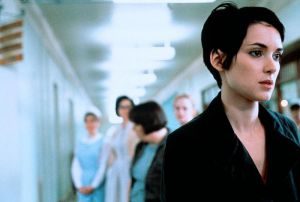 For the final installment of Literary March Madness, let’s take a closer look at a few contemporary depictions of female characters with mental illness. Works by Susanna Kaysen, Gillian Flynn, and Paula Hawkins approach the topic of female characters who are either diagnosed or publicly perceived as having mental illness.
For the final installment of Literary March Madness, let’s take a closer look at a few contemporary depictions of female characters with mental illness. Works by Susanna Kaysen, Gillian Flynn, and Paula Hawkins approach the topic of female characters who are either diagnosed or publicly perceived as having mental illness.
SUSANNA

Winona Ryder as Susanna in Girl, Interrupted
Courtesy of Time for Social Justice
Susanna Kaysen’s memoir Girl, Interrupted is more well-known as the movie starring Winona Ryder and Angelina Jolie, but the memoir went a long way toward inspiring conversations about mental health. As in the other posts in this series, female mental illness has historically been stigmatized; it’s often been considered something to hide. Yet suddenly a woman talked about her own experience with her mental illness and portrayed her time in a mental health facility, and the people she met there, as real and engaging. Instead of refusing to speak about her experience, she explained what it was like in her mind and realistically depicted the other women in the facility. They are friends and occasionally enemies, but they’re all real and are often sympathetic.
CAMILLE

Amy Adams as Camille in the upcoming Sharp Objects
Courtesy of 411Mania
Though Gillian Flynn’s Gone Girl is better known, her debut novel Sharp Objects is more apparent when it comes to its depiction of mental illness. Gone Girl struggles with Amy; there’s something going on (she’s manipulative, sadistic, and feels little consequence or remorse) but it’s never clear. Sharp Objects doesn’t shy away from sharing Camille’s experiences with readers: she’s fresh out of a mental health facility due to her propensity for carving words into her skin. Those who know about her time in the facility tiptoe around her or erase that part of her history. In some cases, her experience is still stigmatized and, in others, people are genuinely concerned about her. While a few characters support Camille, this book ultimately leaves the impression that mental illness makes people a danger, emotionally and/or physically.
RACHEL

Emily Blunt as Rachel in The Girl on the Train
Courtesy of Salon
It seems like everyone has been talking about Paula Hawkins’ The Girl on the Train for the past two years. The brief flashes of Rachel’s life, told at first through her commutes, quickly make it clear that she struggles with alcohol abuse. As the plot thickens and Rachel takes a step beyond observation into action, she becomes obsessed with the missing Megan. But when she goes to the police with information, she is, essentially, turned away. Her testimony is rejected because of her alcoholism and what is perceived as obsession. In this case, she’s often right in her impulses—but she is perceived as untrustworthy and therefore is treated as “less than.”
Perceptions of mental illness have developed in culture as well as literature in recent years. Yet these books relate a world in which characters must hide their psychological states or risk being stigmatized, a world in which we, as readers, perceive the social obstacles (in addition to the mental ones) that these women face. While we may have made strides, mental illness has come to stand in for unreliability and unpredictability in many contemporary novels, which means we still have a way to go.




